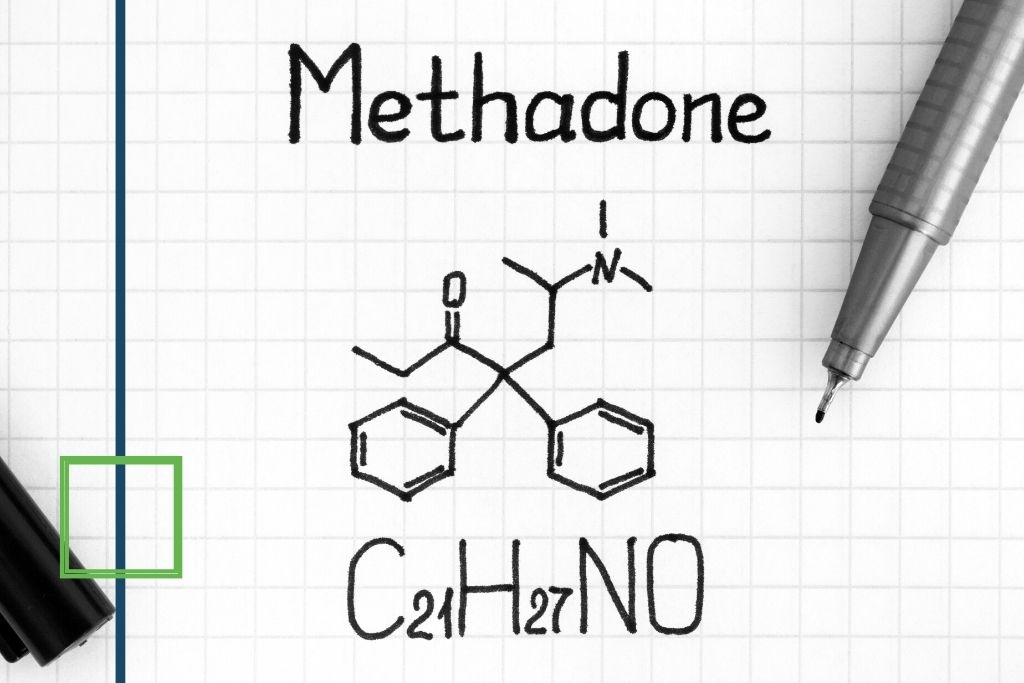What are the Side Effects of Methadone?
Although carefully monitored dosages of methadone are legally and medically acceptable, methadone is still an opioid agonist drug like heroin. It’s important to recognize that, while methadone is a milder drug, it is still a narcotic with a high chance of addiction and dangerous methadone side effects. When an individual takes this medication in any form, they risk experiencing a host of hazardous consequences, which can cause both psychological and physical harm.
Methadone Guide
Methadone Uses
This medication is employed in managing opioid use disorder as an authorized treatment regimen component. Methadone is classified as an opioid analgesic, effectively mitigating withdrawal symptoms that ensue when discontinuing the use of other opioids.
How To Use Methadone HCL Tablet, Soluble
Follow your doctor’s instructions for taking this medication orally. You can consume it with or without food. If you experience nausea, having it with food might alleviate the discomfort. If you encounter nausea, you can also inquire with your healthcare provider or pharmacist about alternative methods to reduce it, such as lying down for 1 to 2 hours with minimal head movement.
Do not chew or swallow the tablets. Instead, dissolve the prescribed dose in 4 ounces (120 milliliters) of water or an acidic fruit beverage (e.g., orange juice) before consumption. Consume the entire mixture immediately. If there is any residual medication in the container, add a small amount of liquid and consume the entire mixture. Do not prepare doses in advance; you should not attempt injecting this medication.
Suppose you’re using this medication to manage moderate to severe pain. In that case, adhering to a regular schedule as prescribed by your healthcare provider rather than taking it as needed for sudden or breakthrough pain is crucial.
The appropriate dosage will be determined based on your medical condition and your response to the treatment.
Abruptly discontinuing this medication can lead to withdrawal symptoms, mainly if used for an extended duration or in high doses. To prevent withdrawal, your doctor may gradually reduce your dosage. If you experience any withdrawal symptoms such as restlessness, alterations in mental or mood state (including anxiety, difficulty sleeping, or thoughts of suicide), watery eyes, runny nose, nausea, diarrhea, excessive sweating, muscle discomfort, or sudden shifts in behavior, promptly inform your doctor or pharmacist.
If you use this medication for an extended period, its effectiveness may diminish. If you notice a decline in efficacy, discussing this with your doctor is essential.
While this medication benefits many individuals, it carries a potential risk of addiction, which may be heightened if you have a history of substance use disorder, such as excessive drug or alcohol use. It’s imperative to adhere precisely to the prescribed dosage to minimize the risk of addiction. Discontinuing methadone maintenance treatment can substantially increase the risk of returning to opioid abuse, so it’s important to seek additional information from your doctor or pharmacist.
If your condition doesn’t improve or worsens, please inform your doctor.
Methadone Side Effects
While taking this medication, you might experience symptoms like nausea, vomiting, constipation, lightheadedness, dizziness, dry mouth, drowsiness, or sweating. Over time, some of these side effects may lessen as your body becomes accustomed to the medication. If any of these effects persist or worsen, it’s essential to inform your doctor or pharmacist promptly.
To mitigate the risk of constipation, consider incorporating dietary fiber into your diet, staying adequately hydrated, and engaging in regular physical activity. Your pharmacist can also recommend an appropriate laxative if needed.
To minimize the chances of dizziness and lightheadedness, make a deliberate effort to rise slowly when transitioning from a seated or reclined position.
Remember that your healthcare provider has prescribed this medication because they have assessed that the benefits outweigh the potential side effects. Many individuals using this medication do not experience severe side effects.
Immediately inform your doctor if you experience any severe side effects, including but not limited to:
- Sleep disturbances are characterized by interrupted breathing (sleep apnea).
- Alterations in mental state or mood, such as restlessness, confusion, or hallucinations.
- Abdominal pain or discomfort.
- Difficulty urinating.
- Indications of impaired adrenal gland function include decreased appetite, unusual fatigue, or unexplained weight loss.
In the event of very severe side effects, seek immediate medical assistance. These may include:
- Seizures.
- Unusual and extreme drowsiness or difficulty awakening.
Although extremely rare, a severe allergic reaction to this medication is possible. If you notice any symptoms indicative of a severe allergic reaction, promptly seek medical attention. Such symptoms may encompass:
- Skin rash.
- Itching or swelling, particularly of the face, tongue, or throat.
- Profound dizziness.
- Breathing difficulties.
Methadone Risks
Methadone carries a substantial risk of abuse and can potentially lead to severe, even life-threatening, respiratory and cardiac issues. These complications are more likely to occur when initiating methadone treatment, switching from another opioid to methadone, or when there’s an increase in the prescribed dose. It’s important to note that breathing problems from methadone may not manifest immediately after a dose. Most cases of cardiac problems have arisen in individuals using high methadone doses for pain management. However, this concern can also arise in those on smaller doses for opioid addiction treatment. It’s crucial not to exceed the prescribed dose or take this medication more frequently than directed. Seek immediate medical attention if you experience unusual symptoms like slow or shallow breathing, rapid or irregular heartbeat, severe dizziness, or fainting.
Consult your doctor or pharmacist regarding the availability of naloxone for treating opioid overdose. It’s also advisable to educate your family or household members on recognizing signs of an opioid overdose and how to respond to it.
For women of childbearing age, it’s essential to discuss with their healthcare provider about the potential risks and benefits of methadone treatment. Pregnancy can affect the drug’s metabolism in your body, so it’s vital to inform your doctor if you are pregnant or planning to become pregnant. During pregnancy, methadone should be used only when necessary. It may slightly increase the risk of birth defects if used during the first two months of pregnancy, and using it in high doses near the expected delivery date can harm the unborn baby. The smallest effective dose should be taken for the shortest duration possible to minimize these risks. Babies born to mothers who have used methadone for an extended period may exhibit severe withdrawal symptoms, which can be life-threatening. If you notice any of these symptoms in your newborn, such as incessant crying, slow or shallow breathing, irritability, trembling, vomiting, diarrhea, poor feeding, or difficulty gaining weight, notify the doctor immediately.
To prevent theft, misuse, or abuse, store this medication securely. If a child accidentally ingests this drug, seek medical assistance without delay.
Methadone Warnings
Before initiating methadone treatment, inform your doctor or pharmacist about any allergies, including allergies to methadone itself or other substances. This medication may contain inactive ingredients capable of triggering allergic reactions or other complications. Seek advice from your pharmacist for additional information.
Share your medical history with your doctor or pharmacist, especially if you have a history of the following conditions:
- Brain disorders such as head injury, tumors, or seizures.
- Respiratory issues like asthma, sleep apnea, or chronic obstructive pulmonary disease (COPD).
- Kidney or liver disease.
- Mental or mood disorders like confusion, depression, or thoughts of suicide.
- Personal or family history of substance use disorders, including drug or alcohol overuse or addiction.
- Gastrointestinal problems include blockages, constipation, diarrhea due to infection, or paralytic ileus.
- Difficulty urinating, potentially due to an enlarged prostate.
- Pancreatic disease, including pancreatitis.
- Gallbladder disease.
Be aware that this medication may induce dizziness or drowsiness. The use of alcohol or marijuana (cannabis) can exacerbate these effects. Refrain from operating machinery, driving, or engaging in activities requiring alertness until you can safely do so. Avoid alcoholic beverages, and discuss your marijuana (cannabis) use with your doctor.
Methadone can potentially lead to a heart rhythm condition known as QT prolongation, which may rarely result in a serious (and rarely fatal) fast or irregular heartbeat, along with other symptoms like severe dizziness or fainting that necessitate immediate medical attention.
The risk of QT prolongation may be elevated if you have specific medical conditions or are taking other medications that can cause QT prolongation. Before using methadone, provide your doctor or pharmacist with a comprehensive list of all the drugs you are currently taking and inform them if you have any of the following conditions:
- Certain heart conditions, including heart failure, a slow heartbeat, or evidence of QT prolongation in an electrocardiogram (EKG).
- A family history of specific heart issues, including QT prolongation in an EKG or sudden cardiac death.
Inadequate levels of potassium or magnesium in your bloodstream can heighten the risk of QT prolongation. This risk may become more significant when using specific medications (such as diuretics or “water pills”) or dealing with conditions such as intense sweating, diarrhea, or vomiting. It’s imperative to discuss with your doctor about the safe use of methadone in such circumstances.
Before undergoing any surgical procedure, inform your doctor and dentist about all the substances you use, including prescription medications, over-the-counter drugs, and herbal products.
Older adults may exhibit heightened sensitivity to the effects of this medication, particularly in terms of confusion, dizziness, drowsiness, slow or shallow breathing, and the risk of QT prolongation (as described above).
While pregnant, employ this medication exclusively if it is unequivocally essential. There is potential harm to an unborn baby, so it is crucial to have a comprehensive discussion with your doctor about the potential risks and benefits. Please refer to the Warning section for additional information.
This medication transfers into breast milk and might adversely affect a nursing infant. If your baby displays unusual drowsiness, difficulties with feeding, or breathing issues, notify your doctor immediately. Consult your doctor for guidance before breastfeeding or if you intend to discontinue breastfeeding.
Methadone Interactions
Interactions with other drugs can alter how your medications function and potentially elevate the risk of severe side effects. This document does not encompass all conceivable drug interactions. Maintain a record of all your products, including prescription over-the-counter and herbal products. Share this list with your doctor and pharmacist. Never commence, cease, or modify the dosage of any medications without obtaining your doctor’s approval.
Certain products that may interact with this medication include pain relievers (mixed opioid agonist-antagonists like butorphanol, nalbuphine, and pentazocine), naltrexone, and samidorphan.
Combining MAO inhibitors with this medication can result in a severe (potentially fatal) drug interaction. During your treatment with this medication, abstain from taking any MAO inhibitors (examples include isocarboxazid, linezolid, metaxalone, methylene blue, moclobemide, phenelzine, procarbazine, rasagiline, safinamide, selegiline, tranylcypromine). In most cases, MAO inhibitors should not be taken for two weeks before or after using this medication. Seek guidance from your doctor regarding the appropriate timing for initiating or discontinuing MAO inhibitors.
Additional medications can impact the elimination of methadone from your body, affecting its efficacy. Examples encompass St. John’s wort, azole antifungals (such as itraconazole), macrolide antibiotics (like erythromycin), rifamycins (including rifampin), and drugs prescribed for seizures (such as carbamazepine), among others.
The potential for severe side effects (e.g., slow or shallow breathing, profound drowsiness, dizziness) may escalate if this medication is used concurrently with other products that can also influence breathing or induce drowsiness. Inform your doctor or pharmacist if you are using other substances such as alcohol, marijuana (cannabis), allergy or cold medications, sleep aids or anxiety medications (e.g., alprazolam, diazepam, zolpidem), muscle relaxants, and psychiatric medications (such as risperidone, amitriptyline, trazodone). Your medications or their dosages may need to be adjusted accordingly.
This medication can disrupt specific laboratory tests, like amylase and lipase levels, potentially leading to inaccurate test outcomes. It is essential to ensure that the laboratory staff and all your medical providers know your use of this medication.
Methadone Overdose
In the event of an overdose with severe symptoms such as loss of consciousness or difficulty breathing, administer naloxone if accessible and immediately dial 911. If the individual is conscious and without symptoms, promptly contact a poison control center.
Methadone Imprints
Below is a dosage chart providing information about Methadone dosage ranges, imprints, color, shape, and tablet versus capsule classification.
| Dosage Range (mg) | Imprint | Color | Shape | Type |
|---|---|---|---|---|
| Methadone 40 mg | M 2540 | Orange | Rectangular (Rounded End) | Tablet |
Even when one only uses methadone briefly, one may notice unpleasant side effects. Some of these are mild, such as:
- Drowsiness
- Dry mouth
- Lightheadedness
- Urinary retention
- Gastrointestinal distress
- Sexual impotence

However, some individuals may experience severe side effects from methadone use, such as:
- Irregular heartbeat
- Depressed respiratory function
- Tremors
- Unstable gait
- Fainting
- Seizures
- Anaphylactic reactions
- Death due to overdose
Call the prescribing physician immediately if you or a loved one experiences any of the above side effects after using methadone.
In addition to physical side effects, this drug can cause psychological side effects, such as:
- Hallucinations
- Insomnia
- Depression
- Anxiety
- Paranoia
- Delusions
- Suicidal ideations
- Impaired concentration
Psychological side effects can be just as severe as physical side effects, so it’s essential to bring these issues to the attention of supervising medical personnel. In some instances, the dosage of methadone will be lowered. In addition, the person may be switched to a different medication, such as buprenorphine if necessary.

Get Your Life Back
Find Hope & Recovery. Get Safe Comfortable Detox, Addiction Rehab & Mental Health Dual Diagnosis High-Quality Care at the We Level Up Treatment Centers Network.
Hotline (877) 378-4154What is Methadone?
Methadone is a prescription drug used to treat severe pain. It is also a medication for detox and maintenance treatment of opioid addiction, such as heroin addiction. Methadone is itself an opioid and can be addictive. Some people can become addicted to methadone as they use it to wean themselves off of another prescription painkiller. Methadone detox and addiction treatment programs can help ensure a safe withdrawal process.
Methadone may be prescribed by physicians and dispensed by community pharmacies for analgesia as a Schedule II drug under the regulations of the Controlled Substances Act [1]. However, when used for the treatment of opiate dependence, methadone’s accessibility is restricted to practitioners, clinics, and pharmacies licensed by the Food and Drug Administration (FDA).
In 2017, about 261,000 people age 12 and older reported using methadone for a non-prescribed purpose at least once in their life [2]. Once the body relies on methadone to function normally, dependency on this drug will develop. In addition, those with methadone dependency will experience withdrawal symptoms if they quit taking the medication.
What Does Methadone Do?
Methadone works by changing how the nervous system and the brain respond to pain. It reduces the painful symptoms of opiate withdrawal. It blocks the euphoric effects of opiate drugs such as morphine, heroin, and codeine, as well as semi-synthetic opioids like hydrocodone and oxycodone.
Opioid-dependent individuals take a daily dose of methadone as a liquid or pill. Pain relief from a dose of methadone lasts about four to eight hours. Methadone is effective in higher doses, especially for heroin users, helping them stay in treatment programs longer.
As with medications used in medication-assisted treatment (MAT), methadone is usually prescribed as part of a comprehensive treatment plan for opioid and opiate addiction that includes therapy and participation in social support programs.
People with methadone prescriptions need to take it exactly as prescribed and not adjust their dose without a doctor’s advice and oversight. It is easy to overdose on methadone due to the strength of one dose. Methadone and Suboxone are both opioids. While methadone is used to treat chronic pain and opioid addiction, Suboxone is only approved to treat opioid addiction.
How is Methadone Used?
Methadone comes as a tablet, a dispersible (can be dissolved in liquid) tablet, a solution (liquid), and a concentrated solution to take by mouth. When methadone is used to relieve pain, it may be taken every 8 to 12 hours. If you take methadone as part of a treatment program, your doctor will prescribe the dosing schedule that is best for you. Follow the directions on your prescription label carefully and ask your doctor or pharmacist to explain any part you do not understand. Take methadone exactly as directed.
If you are using the dispersible tablets, do not chew or swallow before mixing the tablet in a liquid. If your doctor has told you to take only part of a tablet, break the tablet carefully along the lines that have been scored into it. Place the tablet or piece of the tablet in at least 120 mL (4 ounces) of water, orange juice, or a citrus fruit drink to dissolve. Drink the entire mixture right away. If some tablet residue remains in the cup after you drink the mixture, add a small amount of liquid to the cup and drink it all.

Your doctor may change your dose of methadone during your treatment. Your doctor may decrease your dose or tell you to take methadone less often as your treatment continues. If you experience pain during your treatment, your doctor may increase your dose or may prescribe an additional medication to control your pain. Talk to your doctor about how you are feeling during your treatment with methadone. Do not take extra doses of methadone or take doses of methadone earlier than they are scheduled even if you experience pain.
Do not stop taking methadone without talking to your doctor. Your doctor will probably want to decrease your dose gradually. If you suddenly stop taking methadone, you may experience withdrawal symptoms such as restlessness, teary eyes, runny nose, yawning, sweating, chills, muscle pain, widened pupils (black circles in the middle of the eyes), irritability, anxiety, backache, joint pain, weakness, stomach cramps, difficulty falling asleep or staying asleep, nausea, decreased appetite, vomiting, or diarrhea.
Get Help. Get Better. Get Your Life Back.
Searching for Accredited Drug & Alcohol Rehab Centers Near You? Or Mental Health Support?
Even if you have failed previously, relapsed, or are in a difficult crisis, we stand ready to support you. Our trusted behavioral health specialists will not give up on you. Call us when you feel ready or want someone to speak to about therapy alternatives to change your life. Even if we cannot assist you, we will lead you wherever you can get support. There is no obligation. Call our hotline today.
FREE Addiction Hotline – Call 24/7Methadone Side Effects
Along with its needed effects, methadone may cause some unwanted effects. Although not all of these side effects may occur, if they do occur they may need medical attention.
Methadone Side Effects Requiring Immediate Medical Attention
Check with your doctor immediately if any of the following side effects occur while taking methadone:
- Black, tarry stools
- Bleeding gums
- Blood in the urine or stools
- Blurred vision
- Bulging soft spot on the head of an infant
- Change in the ability to see colors, especially blue or yellow
- Changes in skin color
- Chest discomfort or pain
- Confusion
- Cough
- Coughing that sometimes produces a pink frothy sputum
- Darkening of the skin
- Decreased urine output
- Diarrhea
- Difficult, fast, noisy breathing
- Difficulty with swallowing
- Dilated neck veins
- Dizziness
- Dizziness, faintness, or lightheadedness when getting up suddenly from a lying or sitting position
- Dry mouth
- Extreme fatigue
- Fainting
- Fast, slow, or irregular heartbeat
- Headache
- Hives, itching, or skin rash
- Increased sweating
- Increased thirst
- Irregular heartbeat
- Irregular, fast or slow, or shallow breathing
- Loss of appetite
- Mental depression
- Muscle pain or cramps
- Nausea or vomiting
- Numbness or tingling in the hands, feet, or lips
- Pain
- Pale or blue lips, fingernails, or skin
- Pinpoint red spots on the skin
- Puffiness or swelling of the eyelids or around the eyes, face, lips, or tongue
- Seizures
- Sweating
- Swelling of the face, fingers, feet, or lower legs
- Tenderness
- Trouble breathing
- Trouble sleeping
- Trouble urinating
- Unusual bleeding or bruising
- Unusual tiredness or weakness
- Weight gain
Get emergency help immediately if any of the following symptoms of overdose occur while taking methadone:
Symptoms of overdose
- Change in consciousness
- Chest pain or discomfort
- Cold, clammy skin
- Constricted, pinpoint, or small pupils (black part of the eye)
- Coughing that sometimes produces a pink frothy sputum
- Decreased awareness or responsiveness
- Increased sweating
- Irregular, fast, or slow, or shallow breathing
- Loss of consciousness
- No muscle tone or movement
- Pale or blue lips, fingernails, or skin
- Sleepiness or unusual drowsiness
- Slow or irregular heartbeat
- Swelling in the legs and ankles
Methadone Side Effects Not Requiring Immediate Medical Attention
Some side effects of methadone may occur that usually do not need medical attention. These side effects may go away during treatment as your body adjusts to the medicine. Also, your health care professional may be able to tell you about ways to prevent or reduce some of these side effects.
Check with your health care professional if any of the following side effects continue or are bothersome or if you have any questions about them:
- Absent, missed, or irregular menstrual periods
- Anxiety
- Blurred or loss of vision
- Confusion about identity, place, and time
- Constipation
- Decreased interest in sexual intercourse
- Disturbed color perception
- Double vision
- False or unusual sense of well-being
- Halos around lights
- Inability to have or keep an erection
- Irritability
- Lack or loss of strength
- Loss in sexual ability, desire, drive, or performance
- Night blindness
- Overbright appearance of lights
- Redness, swelling, or soreness of the tongue
- Restlessness
- Stopping of menstrual bleeding
- Tunnel vision
- Weight changes
- Welts
Comfortable Facilities & Amenities
High-Quality Addiction & Mental Health Rehabilitation Treatment
Rehab Centers TourRenowned Addiction Centers. Serene Private Facilities. Inpatient rehab programs vary.
Addiction Helpline (877) 378-4154Proven recovery success experience, backed by a Team w/ History of:
15+
Years of Unified Experience
100s
5-Star Reviews Across Our Centers
10K
Recovery Success Stories Across Our Network
- Low Patient to Therapist Ratio
- Onsite Medical Detox Center
- Comprehensive Dual-Diagnosis Treatment
- Complimentary Family & Alumni Programs
- Coaching, Recovery & Personal Development Events
Methadone Side Effects on Heart
Methadone may cause a life-threatening heart rhythm disorder. Call your doctor at once if you have a headache with chest pain and severe dizziness, and fast or pounding heartbeats. Your heart function may need to be checked during treatment.
Methadone Side Effects on Stomach
Methadone can cause various side effects associated with upset stomachs such as diarrhea, vomiting, nausea, and abdominal pain. Many similar symptoms are associated with opiate withdrawal but while taking methadone, these symptoms are generally less severe and will subside on their own in time. If you experience any side effects that prevent you from holding down fluids for a prolonged period, you should seek prompt medical attention as this could lead to dehydration and other serious complications.
Methadone Side Effects on Skin
Feeling itchy after taking methadone isn’t usually a major cause for concern. This is common, and the sensation may subside shortly. A methadone allergy or adverse reaction to methadone, however, is worth discussing with your doctor. Together, you can both determine whether continuing to take methadone is right for you.
Methadone Side Effects on Teeth
Methadone side effects on teeth aren’t often as pronounced as what’s seen with methamphetamines, but it can contribute to some tooth decay. The reason methadone side effects on teeth are present is that it can cause dry mouth, which increases the presence of bacteria and plaque in the mouth.
Methadone Overdose
Methadone overdose happens when a person intentionally or accidentally takes more than the recommended or normal amount of this medicine. This can be on purpose or by accident. Make sure to let your doctors know about any medications you’re taking.
Even though the effects of methadone are different from those of other opioids, such as heroin, your body can still get used to it. This means you might need to take more methadone to feel the same effects. This is called tolerance, and it can happen with any other opioids.
Your body can also become dependent on this drug and other opioids. Your brain relies on the pain relief they bring, and you have withdrawal symptoms if you stop taking them suddenly. Methadone may be packaged and sold under the brand names Methadose, Dolophine, or Physeptone.
Some people may take methadone with other opioid pain killers, such as oxycodone. High doses or combining methadone with other drugs or painkillers can raise someone’s risk of overdose. These painkillers include oxycontin, hydrocodone (Vicodin), or morphine.
World-class, Accredited, 5-Star Reviewed, Effective Addiction & Mental Health Programs. Complete Behavioral Health Inpatient Rehab, Detox plus Co-occuring Disorders Therapy.
CALL (877) 378-4154End the Addiction Pain. End the Emotional Rollercoaster. Get Your Life Back. Start Drug, Alcohol & Dual Diagnosis Mental Health Treatment Now. Get Free No-obligation Guidance by Substance Abuse Specialists Who Understand Addiction & Mental Health Recovery & Know How to Help.
Symptoms of Methadone Overdose
- Vomiting
- Convulsions
- Slow, shallow breathing, known as respiratory depression
- Clammy or bluish skin
- Blue-tinted lips and fingertips
- Extreme fatigue to the point of being unable to stay awake
- Stupor
- Coma
- Death
Combining methadone with other drugs, whether illegal or prescription drugs, can also lead to serious heart problems. These heart problems range from arrhythmia to heart attack.
A person will likely experience many different side effects from their drug use. These methadone side effects may be emotional, physical, or mental. For example, someone in methadone withdrawal will likely experience many uncomfortable feelings and negative thoughts about life during the process of detox. Unfortunately for those with dependency, detox is an unavoidable first step to recovery.
Please, do not try to detox on your own. The Methadone detox process can be painful and difficult without medical assistance. However, getting through the detox process is crucial for continued treatment. We Level Up NJ provide proper care with round-the-clock medical staff to medically assist your recovery. So, reclaim your life, call us to speak with one of our treatment specialists. Our counselors know what you are going through and will answer any of your questions.

Experience Transformative Recovery at the We Level Up Treatment Center.
See our authentic success stories. Get inspired. Get the help you deserve.



Start a New Life
Begin with a free call to an addiction & behavioral health treatment advisor. Learn more about our dual-diagnosis programs. The We Level Up treatment center network delivers various recovery programs at each treatment facility. Call to learn more.
- Personalized Care
- Caring Accountable Staff
- Comfortable Amenities
- Licensed & Accredited
- Renowned w/ 5-Star Reviews
We’ll Call You
Sources:
[1] NCBI – https://www.ncbi.nlm.nih.gov/pmc/articles/PMC1070723/
[2] SAMHSA – Methadone Detox https://www.samhsa.gov/data/sites/default/files/cbhsq-reports/NSDUHDetailedTabs2017/NSDUHDetailedTabs2017.pdf
[3] SAMHSA – https://www.samhsa.gov/medication-assisted-treatment/medications-counseling-related-conditions/methadone

